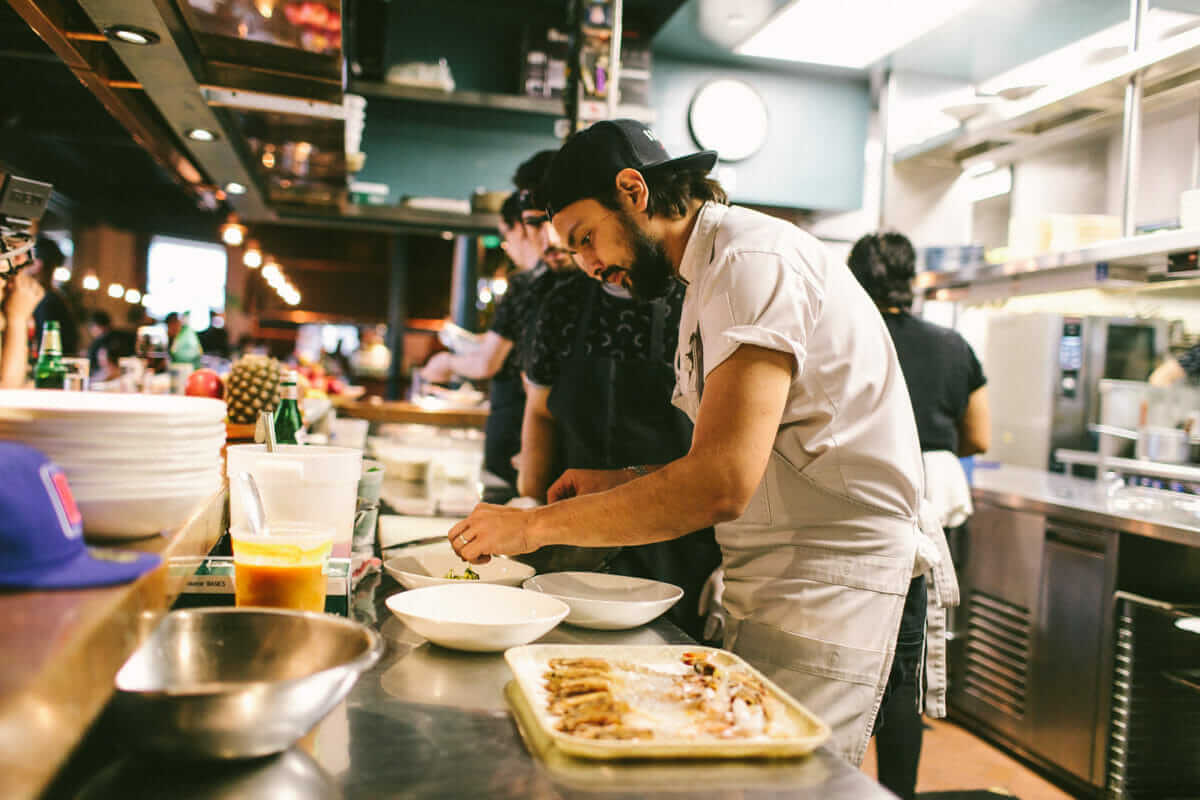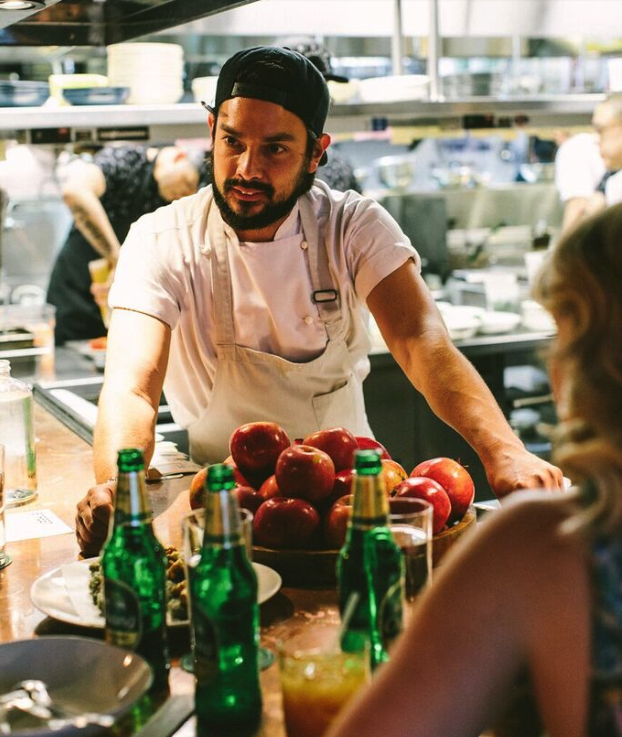This L.A. Chef Partnered with a Farmer to Create the Best Szechuan Peppercorns
How L.A. chef Louis Tikaram paired up with farmer Kong Thao to grow authentic Szechuan peppercorns on his Fresno acreage.
This L.A. Chef Partnered with a Farmer to Create the Best Szechuan Peppercorns
How L.A. chef Louis Tikaram paired up with farmer Kong Thao to grow authentic Szechuan peppercorns on his Fresno acreage.

Sharis Rostamian

It doesn’t look like the most interesting thing on the menu: “Szechuan-style fried fish” may not grab your attention, especially next to dishes like “Check yo neck!” which promises a roll-your-own lamb neck lettuce wrap, and cocktails with names like Rock N Roll Mouthwash.
But when that fish — wok blasted, alongside fresh Szechuan peppercorns, green onions and dried chilis — arrives on the table at E.P. & L.P., a pan-Asian restaurant on a busy corner in West Hollywood, the scent alone tells you that you have ordered correctly. It’s a hot, dry, complicated waft, with high, bright notes of spices and aromatics grounded by the presence of those old delicious reliables: salt and fat. The batter shatters between your teeth and, underneath that, the fish is moist and sweet.
And then something really weird starts to happen: Your mouth goes numb.
Or not numb, exactly, but, like, it buzzes. University College London has actually measured it, and munching on a Szechuan peppercorn will make your lips vibrate to the tune of 50 hertz — the same frequency at which the world’s power grid is usually humming along. A fresh Szechuan peppercorn tastes sort of like a Santa Ana wind, a lemon rind and a whole black peppercorn. It tastes like a berry and then like a bee sting. Eating one reroutes your entire consciousness toward figuring out what’s going on in your mouth.
It’s very weird and very fun.
You’ve probably eaten a Szechuan peppercorn before — they’re common in the cuisine that gives the berry its name — but if you ate them in North America, the peppercorns were almost certainly heat processed before they ever got to your table. (Importing them was formally banned by the United States Department of Agriculture from 1968 until 2005 because of concerns that they would bring a bacterial disease called citrus canker into the country. When that ban was lifted, it was with the caveat that any peppercorns entering the United States must be heated to 140° or above, for 10 minutes or longer, before they reach our ports.) What you’ve tasted was likely a dumbed-down version of the true mouth- and mind-numbing glory of the Szechuan peppercorn —plenty intense, to be sure, but still not as potent as the real thing.
If you want unadulterated peppercorns, you have to find a farmer who grows them locally. That’s how Louis Tikaram, the chef at E.P. & L.P., lucked into the fresh Szechuan peppercorns on his menu: through his friendship with farmer Kong Thao, who grows them on his Fresno acreage.
Partnering with Thao allows Tikaram, an Australian native with Fijian and Chinese heritage, to cook food that is both local and global. Tikaram’s culinary roots are drawn from all over Asia (the E.P. & L.P. menu says its influences are “without regional boundaries”), but the actual ingredients that he cooks with are often sourced from L.A.-area producers. In addition to the peppercorns, he has bought everything from holy basil to Thai eggplant to galangal from Thao for his tables.
“There’s so much of a focus on South American and Mexican foods, as well as taco and food trucks,” he says of L.A.’s food scene. “But there’s this whole southeast Asian community here that is just completely underused. That was the biggest surprise when I moved here. There’s Thai Town, Little Saigon and Hmong and southeast Asian farmers right under your nose. It’s been a really cool experience to use these ingredients, support the local people growing them and teach Angelenos that this is all very common and easily sourced, even in West Hollywood.”
Tikaram’s work expanding people’s palates makes good culinary sense, but it also pays fiscal and environmental dividends for farmers like Thao. When they met, Thao was growing “a lot of kale,” reports Tikaram. Now, as chefs like Tikaram increase their orders for specialty ingredients, Thao can devote more space to cultivating them. Changing what people understand as delicious and local can help transform a landscape and a livelihood.
“It’s been quite uncommon for the food I’m cooking and the people I’m using to source ingredients, but what I think is most uncommon is the people who are actually enjoying it,” admits Tikaram. “I wouldn’t think that, on the corner of Melrose and La Cienega, people would be coming in and eating a traditional nam ya or Szechuan fish dish,” he says of this notoriously touristy, trend-driven part of L.A. “Other chefs tell me, ‘I can’t believe you pulled it off in that area.’”
Tikaram is hoping to continue to pull it off. Thao is working on a hybridized version of the notoriously tricky-to-grow turmeric that he thinks will thrive in California, and Tikaram is looking forward to putting it on his menu. “It’s not too strong, and it’s fresh enough that you can also eat it raw,” reports Tikaram. “Kong says it’s going to be ready this spring, and that’s what I’m waiting for: to be able to showcase really fresh, raw turmeric on the menu. That’s something I think no one would have ever eaten before, so that’s what I want to blow minds with next.”
Follow us
This work is licensed under a Creative Commons Attribution-NoDerivatives 4.0 International License.
Want to republish a Modern Farmer story?
We are happy for Modern Farmer stories to be shared, and encourage you to republish our articles for your audience. When doing so, we ask that you follow these guidelines:
Please credit us and our writers
For the author byline, please use “Author Name, Modern Farmer.” At the top of our stories, if on the web, please include this text and link: “This story was originally published by Modern Farmer.”
Please make sure to include a link back to either our home page or the article URL.
At the bottom of the story, please include the following text:
“Modern Farmer is a nonprofit initiative dedicated to raising awareness and catalyzing action at the intersection of food, agriculture, and society. Read more at <link>Modern Farmer</link>.”
Use our widget
We’d like to be able to track our stories, so we ask that if you republish our content, you do so using our widget (located on the left hand side of the article). The HTML code has a built-in tracker that tells us the data and domain where the story was published, as well as view counts.
Check the image requirements
It’s your responsibility to confirm you're licensed to republish images in our articles. Some images, such as those from commercial providers, don't allow their images to be republished without permission or payment. Copyright terms are generally listed in the image caption and attribution. You are welcome to omit our images or substitute with your own. Charts and interactive graphics follow the same rules.
Don’t change too much. Or, ask us first.
Articles must be republished in their entirety. It’s okay to change references to time (“today” to “yesterday”) or location (“Iowa City, IA” to “here”). But please keep everything else the same.
If you feel strongly that a more material edit needs to be made, get in touch with us at [email protected]. We’re happy to discuss it with the original author, but we must have prior approval for changes before publication.
Special cases
Extracts. You may run the first few lines or paragraphs of the article and then say: “Read the full article at Modern Farmer” with a link back to the original article.
Quotes. You may quote authors provided you include a link back to the article URL.
Translations. These require writer approval. To inquire about translation of a Modern Farmer article, contact us at [email protected]
Signed consent / copyright release forms. These are not required, provided you are following these guidelines.
Print. Articles can be republished in print under these same rules, with the exception that you do not need to include the links.
Tag us
When sharing the story on social media, please tag us using the following: - Twitter (@ModFarm) - Facebook (@ModernFarmerMedia) - Instagram (@modfarm)
Use our content respectfully
Modern Farmer is a nonprofit and as such we share our content for free and in good faith in order to reach new audiences. Respectfully,
No selling ads against our stories. It’s okay to put our stories on pages with ads.
Don’t republish our material wholesale, or automatically; you need to select stories to be republished individually.
You have no rights to sell, license, syndicate, or otherwise represent yourself as the authorized owner of our material to any third parties. This means that you cannot actively publish or submit our work for syndication to third party platforms or apps like Apple News or Google News. We understand that publishers cannot fully control when certain third parties automatically summarize or crawl content from publishers’ own sites.
Keep in touch
We want to hear from you if you love Modern Farmer content, have a collaboration idea, or anything else to share. As a nonprofit outlet, we work in service of our community and are always open to comments, feedback, and ideas. Contact us at [email protected].by Zan Romanoff, Modern Farmer
December 3, 2018
Modern Farmer Weekly
Solutions Hub
Innovations, ideas and inspiration. Actionable solutions for a resilient food system.
ExploreExplore other topics
Share With Us
We want to hear from Modern Farmer readers who have thoughtful commentary, actionable solutions, or helpful ideas to share.
SubmitNecessary cookies are absolutely essential for the website to function properly. This category only includes cookies that ensures basic functionalities and security features of the website. These cookies do not store any personal information.
Any cookies that may not be particularly necessary for the website to function and are used specifically to collect user personal data via analytics, ads, other embedded contents are termed as non-necessary cookies.
In the article, it says, “University College London has actually measured it, and munching on a Szechuan peppercorn will make your lips vibrate to the tune of 50 hertz — the same frequency at which the world’s power grid is usually humming along.” In in the Americas and parts of Asia it is typically 60 Hz.
Wonderful read. Thanks!
Tell us more about where the peppercorns come from! Which trees? Lots more to learn!